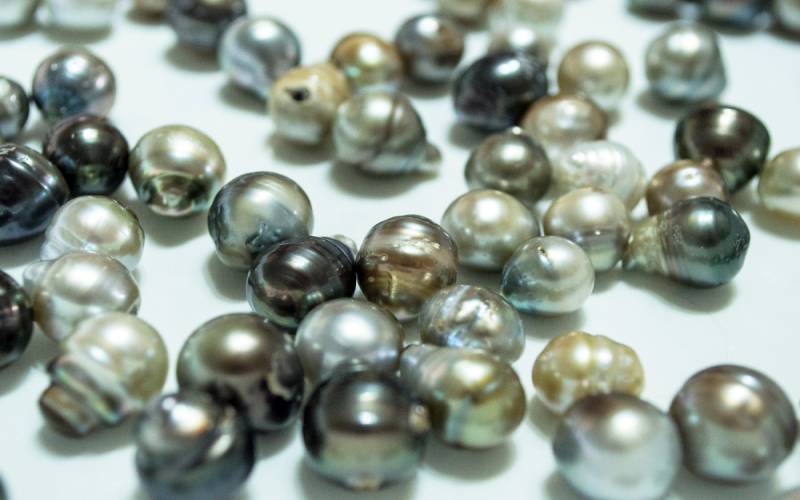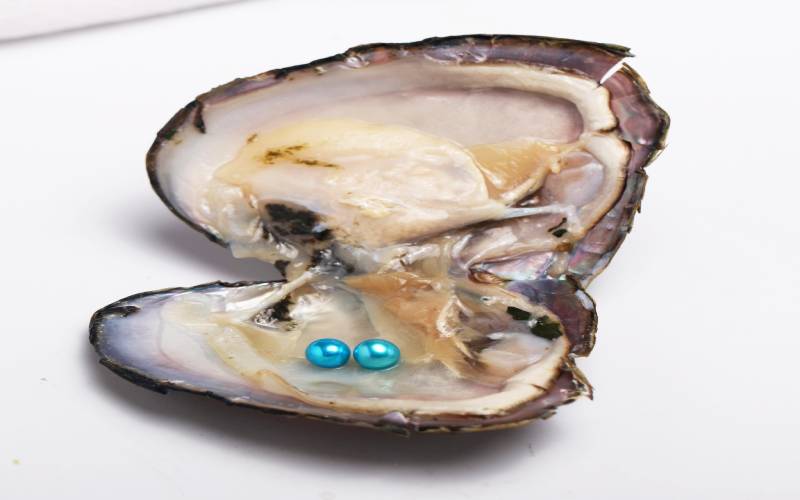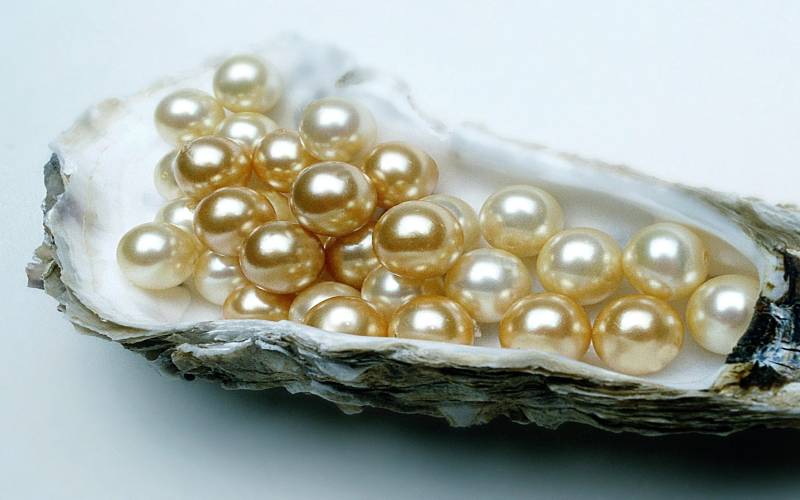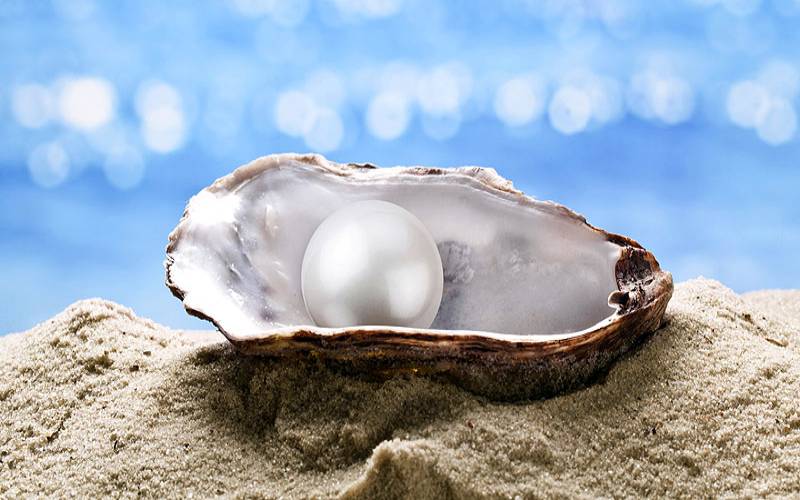
Introduction
The mythological origin of pearls in the Vedic texts can be traced from the ‘Garuda Purana.’ The pearls were formed when the teeth of Valasura the demon got scattered and fell like stars into the oysters found in the oceans of our planet. The pearls formed in these oysters are called oyster pearls. Besides oyster pearls, there are also seven other types of pearls. They are found in conch shells, tusks of wild boars and elephants, head of king cobra and fish, bamboo stems, and clouds.
Fish pearls are round and yellow in colour. Boar pearls are coloured like its tusks and are very rare. Such pearls are auspicious symbols of the Varaha Avathaara of Lord Vishnu. Bamboo pearls appear like hail stones in colour and they are found in bamboos that are found in places which are occupied by religious people.
Pearls from cobra radiate a natural effulgence. After washing, it becomes as lustrous as a polished sword. Anyone possessing this attains piety, good fortune, and becomes a leader among men. As soon as a person acquires a snake pearl he should bring a priest to perform a special pooja to formally install the jewel in the owner’s house.
Cloud pearls are naturally effulgent like the sun and illuminates the sky on dark and cloudy days. It is brighter than the combined light of moon, stars, and fire. A cloud pearl is more precious than the entire earth where the oceans are filled with countless Jewels and gold. Cloud pearls are usually taken away by the demi-gods. It is believed that anyone who comes in possession of a cloud pearl during his lifetime would bring good fortune not only to him but also to the entire human race. No form of evil will touch the land within a radius of 8000 miles of its birthplace.
Now that we have looked into the mythological origin of pearls, let us get to know their scientific origins. Pearls are gems produced through biological processes and so they are referred to as organic gems. Pearls are the foremost among the organic gems. This classification of gems also include amber, ivory, coral and jet. Pearl may well have been the first gemstone used by ancient men, since it requires no lapidary treatment to enhance its beauty. Thus, natural pearl, being one of the nine gems, remains one of the glories of nature.
In India, many of the temples have costumes for deities which are made out of pearls. The Muthangi Seva of Lord Ranganatha at Sri Rangam is one of the most popular pearl costume seva-s in South India. Not to be left behind, the Indian princes competed with one another in augmenting and displaying their collection of pearls. They had patronised pearl trading for over two hundred years. Pearls are being sold worldwide from Hyderabad even today. Even the uneven pearls turned beautiful in the hands of Hyderabadi Craftsmen.
"Telangana & Andhra Pradesh are connected with pearls. Talambralu is an important marriage ritual where the bride and the groom shower each other with rice mixed with pearls, turmeric (Pasupu) and kunkum. This is a tradition in Sita Rama Kalyanam in Bhadhrachalam as well as Sri Venkateswara Kalyanam in Tirumala. The Government Officials carry the talambralu and vastralu for the celestial couple on their heads. It is considered good fortune if one is able to get a pearl which rolls down. Families which are lucky to get it, mix it in the talambralu used in the weddings. Interestingly, carrying the pearl talambralu to Badhrachalam was done by the great devotee, Ramdas. The movie, 'Sampoorna Ramayanam,' shot in Telugu displays a Shy Sita who puts down pearls on Rama. The pearls appear to be pink in the hands of Sita and they appear white while rolling over the lord," stated Jayashri Ramesh, a member of The Verandah Club from Hyderbad.
The Prince of Dholpur, who wore six strands of pearls even to greet his visitors, was aptly called the Prince of Pearls. The Gaekwad of Baroda had the entire collection of pearls in the royal treasury sewn into a wonderful carpet. Pearls worn by kings and men of noble rank should be kept soaked in a solution of mercury and gold in glass containers. The great Tamil epic, ‘Silapadhikaaram,’ mentions that Kannagi had her silambu filled with pearls. Ancient Indo-Roman trade centred around pearls. During the crusades pearls seized in Asia were taken to Europe and kept on public display. The largest pearl in the world is called Pope pearl. It measures 50.8 mm and weighs 450 carats. The renowned banker, Henry Pope, owns it.

Geographical Distribution of Pearl Oysters
The largest pearl banks are located in Japan, India, Persian Gulf, Tahiti, Sri Lanka, Australia, and Philippines. Fine fresh water pearls are found in Scotland, Wales, China, Ireland, France, and U. S. A. India’s Pearl Bank when exploited will make her one of the biggest producers of pearls.
Physical Properties of Pearls
Pearls have a hardness of 2.5 to 4.5 on the Moh’s scale. They have a density of 2.68 to 2.74 g/cu cm in the case of natural pearls and about 2.73 to 2.78 g/cu cm for cultured pearls. Pearl is formed of 82 to 86% CaCo3 in the form of aragonite, 2 to 4% of water and 10 to 14% of conch olin, a horn like substance. Pearls are round, baroque, pear, and button shaped in shades of pink, yellow, cream, green, grey, gun metal, bronze, and black.
Grading
Pearls are graded based on their colour, cultivation, lustre, and cleanness.
Intensity of colour: Pearls are described in terms of colour, i.e., white, pink, cream, etc. A scale of 1 to 5 is used to measure, 1 for the lightest and scale 5 for the darkest.
Cultivation: This is also rated on a scale of 1 to 2. Scale 1 for the pearl with the thinnest layer and scale 5 for the pearl with the thickest layer.
Lustre: Next, we rate lustre on a scale of 1 to 5. Scale 1 for a dull-shine and scale 5 for shimmering-lustre.
Cleanness: The last grading point is cleanness and pearls rating 1 on the scale would be highly spotted goods and scale 5 would be clean goods. If a pearl strand has high intensity, cleanliness, lustre, and cultivation, it will fit into ‘AAA’ quality. Medium rated goods would be classified as ‘AA’ and lower rated goods would be ‘A’ quality. Naturally, to categorise pearls on the basis of intensity, cleanliness, lustre, and cultivation, requires a good deal of experience.

Dimensions
Pearls with a diameter of less than 3 mm are called seed pearls, and still smaller varieties are called dust pearls. Anything more than 10 mm in diameter is rarely found in nature as well as cultured. Of course, there is a new category of cultured pearls which has become increasingly popular today namely, cultured pearls which exceed 10 mm in diameter are better known as South Sea Pearls. The same variety is available in good quantities in the seas of Burma. The Burmese variety is pinkish while the Australian variety looks more silvery.
Testing
The test for the genuine pearl is to soak the specimen overnight in a mixture of warm oil and salt. Another test is to rub the pearl with a piece of dry cotton cloth and rice. A genuine pearl will not lose its lustre. Nowadays, people use x-rays and endoscopy to test pearls.
Type of Pearls
Natural Pearls
Pearl is formed when mollusc deposits a substance called nacre around an irritant. Any mollusc can produce a pearl but only those specimens that have a pearly nacreous lining will form a lustrous pearl suitable to be used as a gem. Pearls of gem quality are produced in salt water almost excessively by the mollusc species Pinctada.
Cultured Pearls
The Chinese may have made cultured pearls as early as the 13th century. In Japan, Mikimoto along with two other Japanese, Nise and Nishikawa, developed a process for culturing whole pearls. Briefly, the procedure consists of cutting a small piece of mantle out of a live oyster, wrapping it around a mother-of-pearl bead and inserting it into the live tissue of another oyster. The oysters thus treated are placed in cages at depths to ensure that the temperature is not less than 50 degree fahrenheit. The pearls are harvested after a few years. The Indian Cultured Pearls are cultivated in the same way as in Japan.
Today, there are very beautiful black cultured pearls that are available in the market which achieve their colour through natural means. This process is an unusual combination of man and nature, in the sense that cultured pearls after being inserted into the oysters are lowered into the water where the next layer which gives rise to the distinctive black colour are formed. These black pearls are formed in the black-lipped oysters in the south seas of Tahiti.
Imitation Pearls
Imitation pearls are made by coating spheres of solid glass or mother-of-pearl with lacquer-like substance obtained from fish scales.
International Pearl trade
Bombay based Hindu traders used to buy the pearls and take them there where they were cleaned and drilled before being sold. Not until the 1st decade of the 20th century did any Europeans enter this trade. It was around 1930 that Mikimoto, Nishikawa, Nise started developing cultured pearls in the beautiful Ago Bay near LSE in Eastern Japan. The diving was done by Japanese women divers known as amas. After patenting and perfecting the art of pearl culture, the Japanese started dominating the world pearl trade. The export of black pearls coming from the black-lipped oysters of Tahiti are placed around 2815 kgs which are valued at several million dollars. The Hyderabad pearls that we buy are not very expensive and are usually imported from China. These are freshwater pearls produced in very large quantities in China. Freshwater pearls sold through Hong Kong or known only for quantity and not quality.
Tips on Pearl Purchase
Pearls are the best buy when they are spherical, large in size, having deep luster, pure and colourful. People can choose colour based on their complexion.
Natural pearls which are imported from Japan are quite expensive. The cultured pearls are sold for a maximum of Rs. 1000/ gram in India. The Chinese freshwater pearls that we refer to as Hyderabad pearls are imported from Hong Kong. A pearl strand of uniform size is costlier than one with sizes ranging from smaller to bigger in a single strand. A pair is much rarer than a single piece.

Pearl Care
Pearl care is extremely important. They have a very long life if they are kept away from perfumes and strong detergents. Perspiration dims the luster and a gentle cleaning with a cloth will help to keep them in pristine condition. They should not be kept in an air-tight environment as they need to breathe. They should be kept away from sunlight. Pearls should not be rubbed against each other. They should be strung in nylon or silicone thread. If this is done, one can expect that pearls brought by the present generation will still be home with pleasure by the next.
Medical and Cosmetic Application
Besides being sought for the aesthetics, pearls were also sought in the field of medicine and cosmetics for its monetary value. Pearls possess approximately 5% protein and are the purest form of calcium deep down from the sea. Indian vaidhyaa-s have always recommended Motitisti (ground pearl to be eaten with honey) for a long and healthy life. It also has the same effectiveness in cosmetics.
Pearl calcium as a medical product prevents hardening of arteries, high blood pressure and stress. As a cosmetic, it helps maintain skin moisture and adjust the balance between alkali and acid on the skin.
Short-tempered people are prescribed to wear pearl rings by the astrologers to help them keep their cool. The fact remains that the pearly elegance, calmness, and softness will surely light up a face with its sparkle. People of the renaissance times would often turn to taking aqua-prelate ground up pearls which were used to restore energy in people. It was quite easy to make. They used to add ground pearl to vinegar, lime juice, sugar, one ounce of rose water, tincture of strawberries, balm, and two ounces of cinnamon water.
 Mr. Rajesh Govindarajulu is one of the founding members of the Verandah Club Pvt. Ltd. He is a leading columnist, historian, jeweler, entrepreneur, and a heritage enthusiast who is earnestly working to revive the past in the light of the present. Experiential learning about the history of Coimbatore is his main course of interest and he is also a panel member of many colleges in the city.
Mr. Rajesh Govindarajulu is one of the founding members of the Verandah Club Pvt. Ltd. He is a leading columnist, historian, jeweler, entrepreneur, and a heritage enthusiast who is earnestly working to revive the past in the light of the present. Experiential learning about the history of Coimbatore is his main course of interest and he is also a panel member of many colleges in the city.
NEXT ARTICLE

At the southernmost tip of this mesmerising ensemble lies the majestic Great Nicobar Island, boasting an impressive landmass of about 910 square kilom...

Bharath has always been a land traversed by spiritual masters/ Guru since time immemorial. These spiritual masters have always upheld the core princip...

South India contains its fair share of unique pilgrimage centres. These divine places of worship have a prominent Sthala Purana, devoted followers, di...